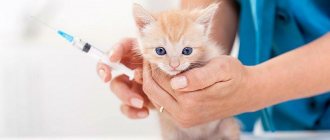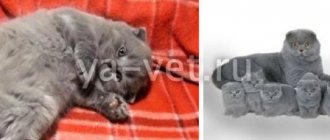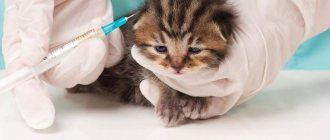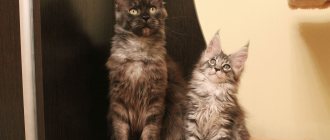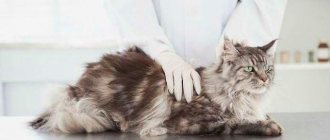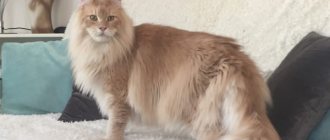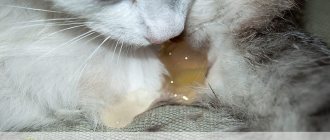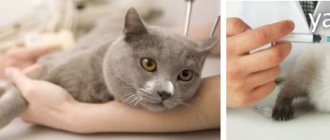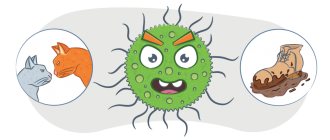Maine Coon cats have fairly good health and good immunity. They have an excellent physique and a high degree of endurance. With proper care and attentiveness of the owners, the life expectancy of Maine Coons can be 15-18 years.
Representatives of this variety of pets may experience diseases typical of this breed. First of all, these are diseases of the genitourinary system, disorders of the musculoskeletal system and skin diseases caused by parasites.
Vaccination
Maine Coons should receive regular vaccinations against various infections and viruses. The first vaccine must be given to the kitten at 2.5-3 months. 10 days before vaccination, it is necessary to carry out prophylaxis against worms, regardless of whether they are present or not. The vaccine will not have the desired effect if there are intestinal parasites in the animal's body.
Before vaccinating a cat, the doctor must examine the animal and measure its body temperature. If the pet looks healthy, then a vaccination is administered. However, if the Maine Coon has a fever and feels unwell, then the vaccination will have to be abandoned until he has fully recovered. Three weeks after the first vaccination, the kitten needs to undergo a second one - against rabies.
Repeated vaccinations against infections and rabies are carried out annually. In this case, the owner of the animal must each time give the cat anti-worm medication 10 days before the scheduled vaccination.
Types of vaccines and diseases
Opponents of vaccination insist that vaccinations are harmful because they weaken the immunity of animals that are supposedly not threatened by any external infection . Experience shows that this opinion is wrong: viruses easily penetrate from the street into an enclosed space, clinging to clothes and shoes. Maine Coons are vaccinated against the most “popular” feline diseases, including panleukopenia, rhinotracheitis, leukemia, calcivirus, chlamydia, herpes and rabies.
Vaccines
The list of in-demand biological products includes:
- Nobivas Tricat Trio (live) – herpes viral rhinotracheitis, panleukopenia, calcivirosis (Intervet, Holland);
- Nobivac Forcat (live) – panleukopenia, calcevirus infection, chlamydia, viral rhinotracheitis (Intervet, Holland);
- Leucorifelin (combined) – infectious rhinotracheitis, panleukopenia, calcivirosis (Merial, France);
- Fel-O-Vax 4 (inactivated) – panleukopenia, herpes viral rhinotracheitis, chlamydia, calcivirosis (Fort Dodge, USA);
- Quadricate (combined) – panleukopenia, calcivirosis, herpes viral rhinotracheitis, rabies (Merial, France);
- Purevax RCP/RCPCh (combined) – panleukopenia, infectious rhinotracheitis, chlamydia, calcivirosis (Merial, France);
- Multifel 4 (inactivated) – rhinotracheitis, panleukopenia, calcivirosis and chlamydia (Narvak, Russia);
- Polivak-TM/Microderm/Vakderm F – dermatomycosis (Russia);
- Nobivas Rabies (Holland)/Rabisin (France) – inactivated rabies vaccines;
- Purevax FeLV – leukemia (Merial, France); Primucell FIP (live) – viral peritonitis (Merial, France).
Viruses mutate, and some drugs are quickly replaced by others: biologists have to create vaccines that can fight new strains.
Vaccine selection
The owner of the Maine Coon is usually determined not so much by the type of vaccine (live, combined or inactivated), but by the country of origin. The veterinary clinic will always ask whether a domestic or imported drug should be administered to the pet. If you are short on funds, opt for the Russian vaccine; if you are not going to save money, opt for an imported one.
Important! You will also need a foreign drug if you intend to travel with your Maine Coon outside the country. Most countries recognize vaccination carried out exclusively with European drugs. The names of the vaccines, as well as the dates of their administration, must be indicated in the international veterinary passport.
Return to content
Intrabreed diseases
The most serious diseases of Maine Coons are hereditary, so the selection of breeding animals must be very careful. The most dangerous hereditary diseases among representatives of this breed are:
- Hypertrophic cardiomyopathy. The cause of this disease is hardening of the heart muscle, which can lead to embolism or complete cardiac arrest. The disease is caused by a disorder in the genes that produce a protein that helps stimulate heart contraction.
- Spinal muscular atrophy is a severe hereditary disorder in which spinal cord neurons die and muscle tissue is destroyed.
- Hip dysplasia. This disease is not life-threatening for the animal, but it turns the pet into a disabled person and is accompanied by lameness, pain and frequent dislocations.
- Polycystic kidney disease. This disease is congenital in nature, in which the kitten is born with cysts in the kidneys. As they grow, they can lead to disruption of the functioning of organs, and then to their complete failure.
No treatment for hereditary diseases can completely restore a cat’s health, so it is very important to identify animals carrying the disease and exclude them from breeding.
What vaccinations do pets need?
Vaccination is the only and reliable way to protect your furry friend from diseases, and the owner from unnecessary stress and material costs. In addition to pets, there are categories of four-legged animals that are subject to mandatory vaccination:
- Individuals that come into contact with other animals, perhaps even homeless ones, leave their home.
- Animals that are preparing for mating.
- Representatives of nurseries taking part in exhibitions.
- Pets whose owners hand them over to animal hotels for foster care.
- Those who are preparing to be sent abroad.
Infectious diseases of Maine Coons
Cats of this breed are susceptible to several serious viral diseases that can greatly compromise their health. Therefore, it is very important to detect the disease in time and begin its treatment.
- Calicivirus is a respiratory infection that affects the respiratory system and watery eyes. The animal often sneezes, ulcers appear on its tongue and palate, its eyes water, and snot appears. In advanced cases, the pet may develop bronchitis, pneumonia and catarrhal tracheitis.
Treatment of kilicyvirus infection involves taking antibiotics and desensitizing therapy. The animal's mouth is irrigated with antiseptics. If necessary, your veterinarian may prescribe eye drops. A sick Maine Coon needs to be provided with comfortable living conditions, a complete diet of soft foods and vitamins.
- Herpesvirus is a disease similar in nature to calicivirus, but accompanied by much more severe symptoms. With herpes virus and Maine Coon, the respiratory system is also affected, the eyes are affected and profuse serous-mucous discharge from the nose appears.
In severe cases, the development of the disease can cause damage to the cat's digestive tract, which may result in loose stools and vomiting. Premature births often occur in pregnant individuals.
Treatment of herpesvirus is based on the use of immunomodulators and antibiotics. Also, the sick animal is given vitamins and medications are instilled into the eyes and nose.
The pet's diet should be based on dietary dishes: boiled fish, meat broth, porridge, warm milk, raw eggs and pureed vegetables.
- Parvovirus - affects the gastrointestinal tract. During this disease, the cat experiences loose stools, severe vomiting, depression and fever. In later stages of the disease, the stool may be watery and contain traces of blood.
There is no specific treatment for parvovirus, but you can significantly alleviate the condition of a sick Maine Coon by creating a secluded, warm place for him and providing a balanced diet and liquid diet.
The best prevention against all viral infections is vaccinations. In addition, the animal must be regularly given vitamins and monitor the state of its immunity. If your pet sneezes frequently, refuses to eat, and shows restlessness, it should be taken to the vet immediately, as timely treatment will help avoid possible complications.
Should antibodies be measured before revaccination?
The Ministry of Health says there is no need to measure antibodies. However, some experts believe that if their level remains high (several times higher than the reference value indicated in the test results), then you can wait with the vaccine. Sometimes before vaccination it is recommended to take a PCR test to make sure that the person does not enter the latent period of infection.
Gunzburg believes that if a person has a high level of antibodies during revaccination, there is nothing wrong with that. Konstantin Chumakov, director of the Global Virology Network center and WHO advisor, agrees with this. “It won’t hurt to get vaccinated once again, without taking into account the level of antibodies, because this will increase the number of antibodies and their quality will improve. That is, antibodies will be able to protect not only from the strain on which the vaccine is made, but also from all other variants, immunity becomes broader. This is the main advantage of revaccination, this booster dose,” Chumakov explained in an interview. “In general, my advice is, if you are afraid for your health, if you are an elderly person, if you have any problems with the immune system, do not refuse revaccination, it will not get worse,” Chumakov concluded. “If you measure your antibodies and they have dropped low, then this is an alarming signal and you should hurry up and get vaccinated again. If your antibodies are at a good level, then there is no rush.”
Pregnancy
In most cat breeds, pregnancy ends no later than 65 days after mating, however, in Maine Coons, labor can begin 68-70 days after conception.
Signs of pregnancy usually appear on the first 21 days after conception. The cat's nipples swell and her eyes become calmer and sleepier. Ingoda females may experience toxicosis, but usually it does not cause much concern.
As the kittens grow, the cat begins to gain weight, her appetite increases and she becomes more affectionate. Throughout pregnancy, the cat must be given special vitamins and ensure that its diet is balanced.
A few days after labor begins, the cat begins to show anxiety. She constantly licks her belly and looks for a secluded corner where she can later give birth in peace. Therefore, it is very important to prepare the place for birth in advance and prepare the necessary items (clean linen rags, sterile solution, scissors).
When labor begins, it is necessary to be present next to the cat and monitor its condition. Usually, veterinarians do not recommend interfering with the birth process since the cat’s instincts themselves will tell the cat what to do. The only thing the owner can do is to monitor whether all the kittens were born alive, and whether the animal is bleeding.
Which vaccine should I use for a booster?
Rospotrebnadzor told RG - Nedelya that revaccination “can be done with any vaccine registered in Russia.” Most often, people vaccinated with Sputnik V are offered Sputnik Light (in fact, this is the first component of the full Sputnik). Alexander Ginzburg has repeatedly presented evidence that this option is effective. And RDIF recently reported that Sputnik Light has been registered for use as a booster in several countries, including the UAE, after all types of vaccines.
Thus, vaccine combinations can be very different. Recently, Rospotrebnadzor reported that the next batch of EpiVacCorona was sent to the regions - in the amount of 1.2 million doses. So in many cases there will be an option for revaccination.
According to Vitaly Zverev, it is better to choose for revaccination not the vaccine with which the primary vaccination was given, but a different type. Why is this so, “RG” - Andrei Pozdnyakov, an infectious disease doctor and head of the Invitro-Siberia medical laboratory, explained to Nedelya. “When you are vaccinated with one vaccine and revaccinated with another, you receive different antigens, the immune system trains on such diversity, and as a result you get a more diverse and, possibly, stronger immune response,” Pozdnyakov said. — There are enough publications that it is good to be vaccinated and revaccinated using different types of vaccines. Although, of course, one type is permissible, and there are no problems.”
Change of teeth in Maine Coons
At approximately four months of age, kittens replace their baby teeth with permanent ones. This process can cause some discomfort to the animal and affect its behavior. Therefore, many owners mistake signs of tooth change for symptoms of disease.
The kitten may become restless, refuse to eat, and become restless. Owners should not worry, as these symptoms pass quickly and do not cause harm to the pet’s health. It is enough to make sure that there is no inflammation at the site of the fallen teeth.
How much does a pedigree cost?
Getting a pedigree from the club for a kitten whose birth is registered according to all the rules costs quite a bit, about 20-30 dollars. It costs almost nothing to register a litter according to all the rules; you just need to follow the rules of the club, get a referral for mating, report the birth of kittens, and buy birth certificates for about $3 apiece. When a buyer is offered two very different prices for a kitten with a pedigree and without a pedigree, the difference between them, as a rule, is not the price of the pedigree itself, but the cost of the right to breed the kitten. Pillow kittens are usually sold at a large discount in price.
, sometimes for only 50% of the cost of the kitten, if it were sold for breeding.
Shedding
Seasonal renewal of fur occurs in spring or early summer. The Maine Coon sheds quite quickly and, with regular brushing, does not cause trouble to its owners.
Older Maine Coons undergo age-related shedding, which lasts from 12 to 18 months. During this period, the animal sheds a lot and loses most of its fur, so it is very important to give your pet vitamins and make sure that the food corresponds to the age norm of the pet.
The following factors can also lead to sudden hair loss:
- skin parasites;
- worms;
- metabolic disease;
- diseases of internal organs;
- unbalanced diet;
- pregnancy;
- elderly age;
- stress.
A veterinarian can help you find out why your cat sheds. He will conduct an examination, make a diagnosis and prescribe treatment.
What to vaccinate against?
Most vaccines allow you to vaccinate a cat against the three most dangerous viral diseases - panleukopenia, calicivirus and rhinotracheitis. Some of them also protect against chlamydia. The rabies vaccination can be done separately, or the combined vaccine quadricat can be used. There are also separate vaccines for feline leukemia virus and FIP, but the effectiveness of these vaccines, especially the FIP vaccine, has been questioned by many.
Do not forget that no vaccination gives a 100% guarantee that your cat will not get sick. Vaccines contain a specific set of strains of each virus, but there is always a chance that you will encounter a rare or new strain - because viruses are constantly mutating. In this case, the vaccination may fail and the cat will get sick. Therefore, despite the fact that your cat is vaccinated, try to limit its contact with outside animals.
Allergies in Maine Coons
If your pet sneezes frequently, has watery eyes, nasal discharge and skin rashes, this may indicate an allergic reaction.
The cause of the allergy can be detected using special tests. Typically, such a reaction in Maine Coons is caused by the saliva of blood-sucking parasites, household chemicals, perfumes, medications and food protein. Treatment consists of identifying and completely eliminating the allergen from the animal’s environment.
Reactions and complications after vaccination
From the body’s point of view, any vaccine is an attempt to introduce foreign substances into it, to which our body naturally reacts. As a rule, vaccination is either asymptomatic or with minor adverse reactions: they are not long-lasting, not persistent and do not lead to any serious health consequences.
But in very rare cases, serious complications occur with the risk of permanent health problems. True, it is worth saying that it is sometimes difficult to distinguish between post-vaccination reactions and post-vaccination complications - the symptoms are often the same: it is even customary to call reactions and complications the same term “adverse reactions”.
Kokav Rabies vaccine culture concentrated purified inactivated (Cocav)
The contents of the vaccine ampoule must be dissolved in 1.0 ml of water for injection. Dissolution time should not exceed 5 minutes. Storage of the dissolved vaccine for more than 5 minutes is not allowed.
The dissolved vaccine is injected slowly intramuscularly into the deltoid muscle of the shoulder, for children under 5 years old - into the upper part of the anterolateral surface of the thigh.
Injection of the vaccine into the gluteal region is not allowed.
Providing anti-rabies assistance
Anti-rabies care consists of local treatment of wounds, scratches, abrasions, salivation areas and subsequent administration of the vaccine for the prevention of rabies COCAV or. if indicated, combined administration of rabies immunoglobulin (RAI) and COCAV rabies vaccine. The interval between the administration of AIH and COCAV is no more than 30 minutes.
Local wound treatment
Local treatment of wounds (bites, scratches, abrasions) and drooling areas should begin immediately or as soon as possible after a bite or injury. It consists of abundantly washing the wound surface for several minutes (up to 15 minutes) with water and soap or another detergent (detergent), or, in the absence of soap or detergent, the injury site is washed with a stream of water. After this, the edges of the wound should be treated with 70% ethyl alcohol or a 5% alcohol solution of iodine.
Sutures should be avoided whenever possible.
Suturing is indicated only in the following cases:
- for extensive wounds - several guiding skin sutures after pre-treatment of the wound;
- for cosmetic reasons (skin sutures on facial wounds);
- suturing of bleeding vessels in order to stop external bleeding.
If there are indications for the use of rabies immunoglobulin, it is used immediately before suturing (see section Dose of rabies immunoglobulin (RAI)).
After local treatment of wounds (damages), therapeutic and prophylactic immunization is immediately started.
Therapeutic and preventive immunization
A detailed scheme of therapeutic and prophylactic immunization and notes to the scheme are presented below in the “Scheme of therapeutic and prophylactic vaccinations with the vaccine for the prevention of rabies COCAV and rabies immunoglobulin (RAI)”.
All persons at risk of contracting rabies are subject to therapeutic and prophylactic immunization. If there are indications for combination treatment, then AIH is first administered and, no more than 30 minutes later, COKAV is administered after it.
Rabies immunoglobulin (RAI)
prescribed as soon as possible after contact with a rabid animal or an animal suspected of having rabies, wild or unknown animals.
Before administration of heterologous
(equine) rabies immunoglobulin, it is necessary to check the patient’s individual sensitivity to horse proteins (see “Instructions for the use of rabies immunoglobulin from liquid horse blood serum”). Heterologous rabies immunoglobulin is administered no later than 3 days after the bite.
Before introducing homologous
(human) rabies immunoglobulin individual sensitivity is not tested. Homologous anti-rabies immunoglobulin is administered no later than 7 days after the bite.
Dose of rabies immunoglobulin (RAI).
Heterologous (horse) rabies immunoglobulin is prescribed at a dose of 40 IU per 1 kg of body weight. The volume of administered heterologous rabies immunoglobulin should not exceed 20 ml. Homologous (human) rabies immunoglobulin is prescribed at a dose of 20 IU per 1 kg of body weight.
Introduction of AIG.
As much of the recommended dose of AIH as possible should be infiltrated into the tissue around the wound and deep into the wound. The unused portion of the drug dose is injected deep intramuscularly into a site other than the rabies vaccine.
Scheme of therapeutic and prophylactic vaccinations with the vaccine for the prevention of rabies COCAV and rabies immunoglobulin (RAI)
| Damage category | Nature of contact | Animal details | Treatment |
| 1 | There is no damage to the skin, no drooling of the skin, no drooling of the mucous membranes. | Rabies patient | Not assigned |
| 2 | Salivation of intact skin, abrasions, scratches, superficial bites of the torso, upper and lower extremities (except the head, face, neck, hand, fingers and toes) caused by domestic and farm animals. | If within 10 days of observation of the animal it remains healthy, then treatment is stopped (i.e. after the 3rd injection). If the absence of rabies in an animal is laboratory proven, then treatment is stopped from the moment the absence of rabies is established. In all other cases, when it is impossible to monitor the animal for 10 days (killed, died, ran away, etc.), continue treatment according to the specified scheme. | Prescribe treatment immediately: COCAV 1.0 ml on days 0, 3, 7, 14, 30, 90 |
| 3 | Any drooling of the mucous membranes, any bites of the head, face, neck, hand, fingers and toes, genitals; single or multiple deep lacerations caused by domestic or farm animals. Any salivation and damage caused by wild carnivores, bats and rodents. | If it is possible to monitor the animal and it remains healthy for 10 days, then treatment is stopped (i.e. after the third injection). If the absence of rabies in an animal is laboratory proven, then treatment is stopped from the moment the absence of rabies is established. In all other cases, when it is impossible to monitor the animal, continue treatment according to the specified regimen. | Start immediately combined treatment with rabies immunoglobulin: AIH on day 0 (see Dose of rabies immunoglobulin (RAI)) and rabies vaccine: COCAV 1.0 ml on days 0, 3, 7, 14, 30 and 90 |
Notes to the Scheme of therapeutic and prophylactic vaccinations with the vaccine for the prevention of rabies COCAV and rabies immunoglobulin (RAI):
1. Doses and regimens of therapeutic and prophylactic immunization are the same for children and adults.
2. A course of therapeutic and prophylactic immunization is prescribed regardless of the timing of the victim’s request for rabies treatment, even several months after contact with an animal with rabies, an animal suspected of having rabies, a wild or unknown animal.
3. For persons who have previously received a full course of therapeutic and prophylactic or preventive vaccinations, from the end of which no more than 1 year has passed, three injections of the vaccine for the prevention of rabies COCAV, 1.0 ml, are prescribed on days 0, 3, 7; if a year or more has passed or an incomplete course of immunization has been carried out, then vaccinations are carried out in accordance with the given “Scheme of therapeutic and prophylactic vaccinations with the vaccine for the prevention of rabies COCAV and rabies immunoglobulin (RAI).”
4. After a course of therapeutic and prophylactic or preventive immunization, the vaccinated person is issued a certificate (certificate of preventive vaccinations) indicating the type and series of drugs, the course of vaccinations and the presence of post-vaccination reactions.
Preventive immunization
The vaccine is administered intramuscularly into the deltoid muscle of the shoulder, 1.0 ml on days 0, 7 and 30. Revaccination is carried out once, in a dose of 1.0 ml every year and then every three years.
Preventive immunization scheme
| Primary immunization | Three injections on days 0, 7 and 30, 1.0 ml each |
| First revaccination after 1 year | One injection, 1.0 ml |
| Subsequent revaccinations every 3 years | One injection, 1.0 ml |
Preventive immunization of populations at increased risk of rabies infection is carried out in vaccination rooms of medical institutions, where they fill out and issue a “Certificate of Preventive Vaccinations”, where all the necessary information is entered (names, series, doses, multiplicities and dates of receipt of drugs).
